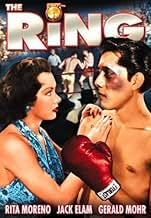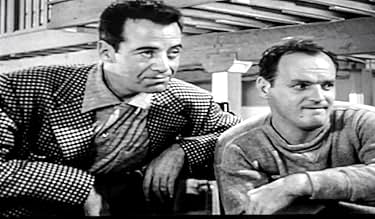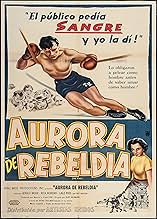Aggiungi una trama nella tua linguaA young American of Mexican decent in East Los Angeles, California uses the boxing ring to make a better life for himself and his family, and learns as much about being a Latino in a white s... Leggi tuttoA young American of Mexican decent in East Los Angeles, California uses the boxing ring to make a better life for himself and his family, and learns as much about being a Latino in a white society as he does about boxing.A young American of Mexican decent in East Los Angeles, California uses the boxing ring to make a better life for himself and his family, and learns as much about being a Latino in a white society as he does about boxing.
Recensioni in evidenza
East LA local Lalo Rios has a quick temper and quick hands. When a fight promotor (Gerald Mohr) gets him out of a street scrap arrest he takes him on as a boxer, much to his proud father's chagrin. Things start out rosy as "Kid Kansas" wins his first three fights. The undisciplined Rios soon goes diva as his skills dull and his beatings increase.
The Ring is a sincere little effort that shows brief flourishes of style but is unable to go the distance or rank with the heavyweights of the genre. There are split second shots that evoke Raging Bull and Mohr's manager is a switch from the usual exploitive orgre to down to earth realist but Lalo Rios's pugnacious Tomas is a flat lead unable to go the distance.
The film's most notable feature is the injection of institutional racism that culminates in a Beverly Hills restaurant scene which not only comments on race but status as well. Neither champ or tomato can The Ring is a game low-budget effort.
The Ring is a sincere little effort that shows brief flourishes of style but is unable to go the distance or rank with the heavyweights of the genre. There are split second shots that evoke Raging Bull and Mohr's manager is a switch from the usual exploitive orgre to down to earth realist but Lalo Rios's pugnacious Tomas is a flat lead unable to go the distance.
The film's most notable feature is the injection of institutional racism that culminates in a Beverly Hills restaurant scene which not only comments on race but status as well. Neither champ or tomato can The Ring is a game low-budget effort.
Even the cheap production values of The Ring which admittedly looks like it was shot on chump change give it a look of authenticity. The Ring is a fine film about a young Mexican-American kid who thinks that boxing could be his ticket out of the slums. The lead here is played by young Lalos Rios who went on to a substantial career for the next twenty years.
Better known of course is Rita Moreno who was doing her fourth film and she plays Rios's girl friend. It's a part light years different from Anita in West Side Story.
Lalos Rios plays young Tommy Cantanios whose family is going through a real financial crisis. His father is laid off from work and they owe a lot of money for furniture on credit. Young Tommy asks to help, but his father, Martin Garralaga sluffs off the offer.
In the history of Mexican-Americans, The Ring tells its story in a time almost halfway between the zoot suit rioters of the Forties and the organization of migrant farm laborers by Cesar Chavez in the Sixties. Still a time when the discrimination that brought on the zoot suit riots was very real.
After a couple of encounters with some discrimination young Rios gets a lift by chance from fight manager Gerald Mohr who sees some possibilities in the kid. He takes him under his wing and changes his professionally to Tommy Kansas. He and trainer Robert Osterloh bring him up the ranks slowly.
Of course Rios is impatient and Mohr starts to question whether he really does have the talent to make it really big in the fight game.
The Ring is a very realistic film about the fight game and life in East Los Angeles in the Fifties. Look also for good performances from Jack Elam as a sleazy fight promoter and from Art Aragon who was a popular welterweight boxer from back in the day who later went into acting after his ring days were done.
Rios learns two very valuable lessons, one is best summed up by that eminent American philosopher Clint Eastwood who once remarked a man's got to know his limitations. But even more important Rios learns that The Ring is not the only place he can fight for his beliefs and his people. The arena of life is not just a squared circle.
Better known of course is Rita Moreno who was doing her fourth film and she plays Rios's girl friend. It's a part light years different from Anita in West Side Story.
Lalos Rios plays young Tommy Cantanios whose family is going through a real financial crisis. His father is laid off from work and they owe a lot of money for furniture on credit. Young Tommy asks to help, but his father, Martin Garralaga sluffs off the offer.
In the history of Mexican-Americans, The Ring tells its story in a time almost halfway between the zoot suit rioters of the Forties and the organization of migrant farm laborers by Cesar Chavez in the Sixties. Still a time when the discrimination that brought on the zoot suit riots was very real.
After a couple of encounters with some discrimination young Rios gets a lift by chance from fight manager Gerald Mohr who sees some possibilities in the kid. He takes him under his wing and changes his professionally to Tommy Kansas. He and trainer Robert Osterloh bring him up the ranks slowly.
Of course Rios is impatient and Mohr starts to question whether he really does have the talent to make it really big in the fight game.
The Ring is a very realistic film about the fight game and life in East Los Angeles in the Fifties. Look also for good performances from Jack Elam as a sleazy fight promoter and from Art Aragon who was a popular welterweight boxer from back in the day who later went into acting after his ring days were done.
Rios learns two very valuable lessons, one is best summed up by that eminent American philosopher Clint Eastwood who once remarked a man's got to know his limitations. But even more important Rios learns that The Ring is not the only place he can fight for his beliefs and his people. The arena of life is not just a squared circle.
A young Rita Moreno playing the sweet girl next door,Jack Elam in a tweed sport coat and floppy hat as a sleazy boxing promoter...Wow,I can't ask for much more.Movie was made when I was a youngster,watching it now it looks so nostalgic almost like being in a dream for me.Many scenes look to be shot on location and remind me of my own slum.Shiny old cars,carhops,old houses,etc are just icing on the cake.The story?Young Chicano trying to bust out of poverty by being a boxer also facing discrimination which was more blatant back then.All the cast gives realistic presentations...Some things don't change with time,like an angry young man being calmed down by the soft words of his girl(Rita)...Although crazy about boxing I don't like boxing movies which this is,part of the reason I didn't give it a 10.
Outstanding overlooked boxing film with an outstanding cast of B actors. Lalo Rios stands out and it seems his fictional boxing career mirrored his real life acting career, in that he showed alot of potential, but for some unexplained reason, never became successful. Filmed on location in early 1950s California in glorious black and white. Very realistic and unromantizied look at boxing and ethnic discrimination. Honestly, I think this film is better then Raging Bull.
Lalo Rios is Tommy, a young boy who turns to boxing to help out his struggling family in early 1950's Los Angeles. He learns about a lot more than just how to fight in this 80 minute art house type drama, including about how his values don't always mix with the values of those trying to get him ahead in the business. Rios is outstanding, and it is surprising considering he never became a bigger star. The only name actor in this film is Academy Award Winning Rita Moreno as his sweet girlfriend. Then just starting out her career with a few appearances in MGM musicals ("The Toast of New Orleans" & "Pagan Love Song") to name a few, the future "Anita" of "West Side Story's" film version is one of the few good people in Tommy's life who cares for him, not for his success as a boxer.
The scene where Tommy and his pals go into a restraunt in Beverly Hills after a boxing match Tommy looses is quite revealing about attitudes towards Latinos (and probably other minorities) during the early 1950's. The waitress reluctantly places glasses of water (spilling most of it) at their table, then calls the police, prepared for trouble. She then goes about her business, ignoring them, and waiting on the white customers at the tables around them. When the policeman arrives, he seems suspicious at first, but then is actually sympathetic when he realizes that the boys are not up to no good, just misunderstood. It is a remarkable scene, not played for any type of shock value, but just to make the audience aware of how little prejudices can lead to bigger ones, and ultimately, cause the types of race and gang wars seen in the newspapers every day.
There are also some touching understated moments where Tommy's younger brother begins to show idol worship, and Tommy begins to realize how his ambitions are affecting the future of his younger brother. This leads to the final scene where Tommy confronts all of these demons. The final is very powerful, leading to an ending which some might consider "incomplete", but it actually does reflect reality, ending one chapter in his life, and moving onto wherever his life happens to take him.
While not a fan of boxing movies, I found "The Ring" to be engrossing because of the sympathetic way it presented the young hero, not type casting. A bit at the beginning where Tommy's father, ailing at work, is called a lazy Mexican by two American tourists, is very revealing too about the way many white people then (and even today) look at people of different cultures. Anyone who sees this film will find the scene disturbing, and may see the prejudices in themselves that they have always tried to keep hidden. For a small and simple film, "The Ring" says a lot, and achieves more than some of the bigger films released at the same time.
The scene where Tommy and his pals go into a restraunt in Beverly Hills after a boxing match Tommy looses is quite revealing about attitudes towards Latinos (and probably other minorities) during the early 1950's. The waitress reluctantly places glasses of water (spilling most of it) at their table, then calls the police, prepared for trouble. She then goes about her business, ignoring them, and waiting on the white customers at the tables around them. When the policeman arrives, he seems suspicious at first, but then is actually sympathetic when he realizes that the boys are not up to no good, just misunderstood. It is a remarkable scene, not played for any type of shock value, but just to make the audience aware of how little prejudices can lead to bigger ones, and ultimately, cause the types of race and gang wars seen in the newspapers every day.
There are also some touching understated moments where Tommy's younger brother begins to show idol worship, and Tommy begins to realize how his ambitions are affecting the future of his younger brother. This leads to the final scene where Tommy confronts all of these demons. The final is very powerful, leading to an ending which some might consider "incomplete", but it actually does reflect reality, ending one chapter in his life, and moving onto wherever his life happens to take him.
While not a fan of boxing movies, I found "The Ring" to be engrossing because of the sympathetic way it presented the young hero, not type casting. A bit at the beginning where Tommy's father, ailing at work, is called a lazy Mexican by two American tourists, is very revealing too about the way many white people then (and even today) look at people of different cultures. Anyone who sees this film will find the scene disturbing, and may see the prejudices in themselves that they have always tried to keep hidden. For a small and simple film, "The Ring" says a lot, and achieves more than some of the bigger films released at the same time.
Lo sapevi?
- QuizRobert Altuna received an "Introducing" credit.
- BlooperBefore the final boxing match; real film footage of Art Aragon is clipped into the fight. His three corner men in the real footage are clearly completely different from the actors playing his corner men in the movie.
- ConnessioniReferenced in Crisis in Morality (1962)
I più visti
Accedi per valutare e creare un elenco di titoli salvati per ottenere consigli personalizzati
Dettagli
- Data di uscita
- Paese di origine
- Lingue
- Celebre anche come
- Pachuco
- Luoghi delle riprese
- Azienda produttrice
- Vedi altri crediti dell’azienda su IMDbPro
- Tempo di esecuzione
- 1h 19min(79 min)
- Colore
- Proporzioni
- 1.37 : 1
Contribuisci a questa pagina
Suggerisci una modifica o aggiungi i contenuti mancanti


























